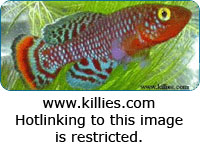Chloramine and its cures.

Originally Posted by
RonWill
Recently, after water changes, I've been hit by casualties (much like what Lily has experienced and she's living near my district). About a week back, I lost 50+ 1cm N'sukka fry that were very stable and eating well.
How long does chloramine stay in the water and how does one effectively/safely convert/dissipate the chemical into a harmless compound?
Five weeks is a typical chloramine half life. If you change water, it just never goes away. Period. [Aerated, chlorine goes in less than 24 hours, when not stabilized by ammonium. That made partial changes pretty safe with only chlorine in the water.]
"Amquel," "Ammo Lock 2," "Prime," and a host of other dechloraminators are available in the trade. Avoid "Amquel 2" and "Novaqua" as they are not the same thing.
Just don't use any product claiming to "break the ammonium-chlorine bond." It is just old photographer's hypo (sodium thiosulfate) hiding in an expensive bottle. [It is a couple of bucks a dry pound at the photo shop.] It releases a possibly lethal dose of ammonia unless your tank pH is fairly acidic.
The dechloraminators are fine for preparing shipping water, but that and neutralizing ammonium in incoming fish water (which is *always* discarded) are about the only times I use them. They are variations on formaldehyde, which is a tanning agent that kills smaller critters, like Daphnia and infusoria.
Slow carbon-block filtering is the best solution for breeders. Small fishrooms can use the taste and odor filters for refrigerator ice makers. In Fremont, when I had 150 tanks and containers to feed every day, I used two large (whole house) filters in series. [The water went through #1 and then through #2.]
Their output was trickled into a large food-grade trash barrel with a float valve to cut it off when nearly full. A small valve cut the average flow enough to be way slower that any level that tested for any chlorine in the outflow. Contact time is vital for safe chloramine removal. Chloramine and chlorine read exactly the same in the standard test kits.
I installed a secong drip-irrigation valve and a short piece of polyethylene tubing between the two filters so I could test there for possible "punch through" as the first cartridge started to saturate at about 6-9 months. When a trace of chlorine tested with a faint bit of yellow, I threw the saturated first cartridge away, and replaced it with the essentially unused #2. A new one went into the place of #2.
I cannot believe you guys have not religiously and regularly tested for chlorine! How do you tell if your dechloraminator or carbon filter are even working? How do you know the water dept. hasn't overdosed, today? I put it right up there with osmosis as an important thing for a breeder to be on top of.
If you buy at the swimming pool or spa places, the test is about 10-20 times cheaper than at the LFS, but it is exactly the same stuff. My last bout of this, the LFS got $10 for a chlorine test kit, and a bottle with over twice as much reagent was US$0.78 at the Home Depot spa department (without the color chart).
Spas, hot-tubs and swimming pools are natural bacteria culture media. You must have a source of chlorine test kits for them in SG. Look at the color chart that comes with them. It should be identical to the one at the fish shop. You don't need the chart, BTW, as any trace of yellowish color is BAAAAD! Be sure to view against a very white background so you can detect the slightest color tint.
Using carbon filtering instead of the formaldehyde-like stuff, my Java Moss teemed with rotifers and paramecia. One drop of Liquifry No. 1 was enough to create a swarming cloud by the next day. The babies love it and they aren't killed or stunted by either chlorine burns or ammonia.
Darn! Did I slip into Sermon Mode again? Sorry about that! 
Wright
01 760 872-3995
805 Valley West Circle
Bishop, CA 93514 USA
Originally Posted by RonWill













 Reply With Quote
Reply With Quote
 I think I have seen a few of those, before.
I think I have seen a few of those, before. 








Bookmarks